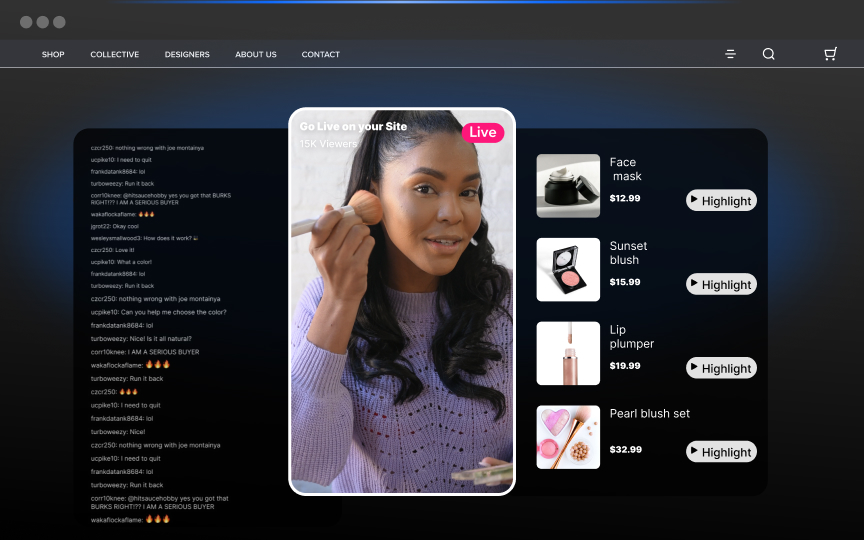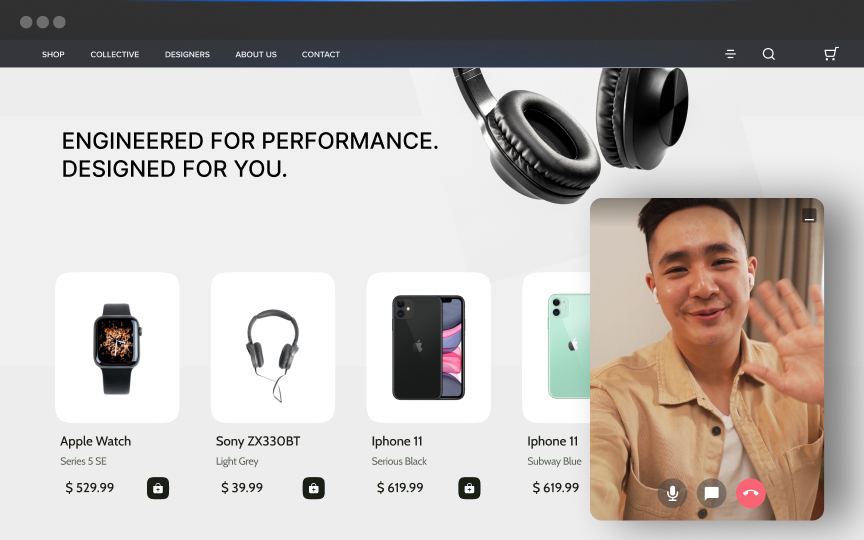To stand out in the competitive e-commerce landscape, applying the 12 powerful eCommerce branding strategies outlined in this article can help elevate your business, build deeper customer connections, and drive lasting engagement and sales.
Strategy 1: Establish a Strong Brand Voice
A consistent brand voice builds recognition and trust. Align your voice with your values and customers’ expectations across all communication channels.
Create a Consistent Voice
Developing a cohesive brand voice is essential for building recognition and trust. Your brand voice should reflect your company’s values and resonate with your audience. To achieve consistency:
- Define your brand's tone and style: Decide whether your communication is formal, casual, friendly, or professional.
- Create comprehensive brand guidelines: Document your preferred language, terminology, and messaging. Include examples of on-brand phrases and words to avoid.
- Maintain uniformity across all channels: Use the same tone and messaging on your website, social media, emails, and customer support interactions.
Tailor Communication to Audience Preferences
Understanding your customers’ preferences is crucial for crafting messages that resonate. To tailor your communication:
- Know your target audience: Research demographics, interests, and pain points. Use surveys, analytics, and customer feedback to gather insights.
- Use language that appeals to them: Incorporate phrases and terminology your audience uses.
- Adapt your messaging: Test different approaches to see what resonates best.
- Listen to customer feedback: Use reviews and comments to understand customer sentiments.
Strategy 2: Understand Your Target Market
Knowing your audience through buyer personas and market research helps you tailor products, messaging, and marketing efforts to meet their needs.
Develop Buyer Personas
Start by creating detailed buyer personas that represent your ideal customers. Use data from past purchases, website analytics, and customer surveys to identify common traits and behaviors. Consider:
- Demographics: Age, gender, location, income level
- Psychographics: Interests, values, lifestyle choices
- Online Behavior: Preferred social media platforms, shopping habits
By understanding their needs and challenges, you can tailor your products, messaging, and marketing efforts.
Conduct Market Research
Thorough market research keeps you informed about industry trends and customer expectations. Begin by analyzing your competitors:
- Evaluate Competitor Customer Bases: Identify who your competitors are targeting and how they position their brands.
- Analyze Competitor Reviews: Look at customer reviews on competitor sites to find gaps or areas for improvement.
Regularly gathering and analyzing market data ensures your brand stays relevant and can adapt to changing customer needs.
Strategy 3: Unique Brand Positioning
Your Unique Selling Proposition (USP) is the distinctive value that your brand offers to customers. Identifying and highlighting this uniqueness helps your audience understand why they should choose you.
- Identify What Makes You Unique: Reflect on what differentiates your products or services.
- Understand Your Audience: Knowing your customers' preferences and values helps you align your USP with what matters to them.
- Craft a Clear Message: Develop a concise statement that encapsulates your USP.
- Integrate Your USP Across All Touchpoints: Consistently communicate your USP on your website, social media, product packaging, and marketing campaigns.
Strategy 4: Emphasize Authenticity
Build trust by maintaining transparency and showcasing real customer experiences through user-generated content and behind-the-scenes insights.
Maintain Transparency
Transparency is key to building trust with your audience. Openly share your brand’s mission, values, and story. Explain why you founded your company and what drives you. Be clear about your business practices, providing detailed information about your products.
Showcase Real Experiences
Authentic experiences resonate deeply with customers. Encourage users to share their stories, reviews, and photos of your products. Feature this user-generated content on your website and social media.Share behind-the-scenes glimpses of your business. Use video content to connect more personally with your audience.
Strategy 5: Build Emotional Connections
Emotional connections and building community turn casual shoppers into loyal customers. Use storytelling to create a relatable, emotional connection with your audience, turning casual shoppers into loyal customers.
Use Storytelling in Marketing
Stories captivate and inspire, helping to enhance customer connections. Share your brand’s journey, mission, and the values that drive you. Incorporate your story into product descriptions and packaging.Video is a powerful tool for storytelling. Create behind-the-scenes videos to showcase your team’s dedication.
Create Relatable Content
Relatable content helps customers see themselves using your products. Use language and imagery that reflect their experiences and needs. Engage with your audience through educational content like how-to guides and tutorials.Encourage customers to share their own stories. Feature user-generated content such as photos, reviews, and testimonials on your platforms.
Strategy 6: Use User-Generated Content (UGC)
User-Generated Content can enhance your brand’s authenticity and build trust with potential customers.
Encourage Customer Engagement
Encouraging your customers to share their experiences through User-Generated Content fosters a community around your brand. Invite them to post reviews, photos, and videos of your products on social media platforms.
Highlight UGC on Your Platforms
Displaying user-generated content on your website and other channels adds a layer of authenticity that traditional marketing can’t replicate. Showcase customer photos, reviews, and testimonials prominently on product pages.
Strategy 7: Implement Eco-Friendly Initiatives
Embracing eco-friendly practices can enhance your brand and appeal to environmentally conscious consumers.
Align with Sustainability
Start by developing a clear mission statement that reflects your dedication to the environment. Partner with relevant non-profit organizations or donate a portion of sales to environmental charities.
Communicate Environmental Impact
Transparency is key in building trust with your customers. Share the positive effects of your eco-friendly initiatives through your marketing channels. Use visuals like infographics or videos to explain the impact of your sustainable efforts on the environment.
Strategy 8: Create Interactive Experiences
Interactive content, like shoppable videos and live streaming, engages customers and creates a dynamic, immersive shopping experience.
Integrate Shoppable Videos
Shoppable videos combine visual storytelling with the convenience of online shopping, a key component of current video marketing trends. By creating shoppable video, you allow customers to shop directly by clicking on products within the video, enhancing online shopping experiences and driving sales.
Implement Live Streaming
Live streaming offers a dynamic way to interact with customers in real time. Hosting video shopping events can generate excitement, encourage spontaneous purchases, and create a sense of urgency. It also allows customers to ask questions and see products in action, creating a more interactive and engaging experience.
Strategy 9: Prioritize Visual Identity
Your visual identity is a vital part of your brand that captures attention and communicates your values.
Focus on Logo, Typography, and Color Schemes
Invest in professional design for your logo, typography, and color schemes. High-quality visuals communicate professionalism and trustworthiness. Consistent use of these elements reinforces your brand’s identity across all touchpoints, making it more recognizable to your audience.
Use Consistent Branding Elements
Consistency is key in building a strong brand. Ensure that your visual elements are uniform across all platforms, from your website and social media to your packaging and advertisements. By maintaining uniformity, you increase brand recognition and build trust with your customers as they come to associate certain visual elements with your brand.
Strategy 10: Speak Your Customers' Language
Understanding and connecting with your audience is crucial to building a strong e-commerce brand.
Tailor Copy to Customer Preferences
To connect with your customers, it’s essential to understand who they are and how they communicate. Use the language your customers use—whether formal, casual, or somewhere in between. Avoid jargon unless your audience is familiar with it, and focus on clear, concise messaging that resonates with their values and needs.
Engage Through Relevant Content
Creating content that speaks directly to your audience’s interests keeps them engaged and builds trust. This could include blog posts, videos, and social media updates that align with your customers' preferences and address their pain points.
Strategy 11: Optimize Social Media Presence
Engaging with your audience on social media builds brand loyalty and increases visibility.
Engage Customers on Social Platforms
Interact with your audience on platforms like Instagram, Facebook, and YouTube. Share content that resonates with your customers, such as behind-the-scenes videos, customer stories, or interactive polls. Engage with comments and direct messages to build a community around your brand.
Run Targeted Social Media Campaigns
Use targeted campaigns to reach specific demographics and maximize impact. Platforms like Facebook and Instagram allow you to run ads tailored to your audience’s preferences, interests, and behaviors, helping you reach the right people at the right time.
Strategy 12: Maintain Consistency Across Touchpoints
Consistency across all platforms is key to building a strong e-commerce brand. An effective omnichannel retail strategy ensures this consistency, enhancing the customer experience.
Ensure Cohesion in Customer Interactions
Use the same logo, colors, fonts, and visual styles across your website, social media, emails, and marketing materials. Integrate video commerce consistently into these touchpoints.Develop comprehensive brand guidelines that ensure everyone on your team adheres to the same visual and tonal elements. This consistent branding reinforces your brand’s identity, making it more recognizable to your customers.
Regularly Review Branding Elements
Over time, your brand may evolve, so it’s important to review and update your branding elements regularly. As your business grows, you might need to refresh your logo, update your color scheme, or adjust your messaging to better reflect your brand’s direction and your audience’s expectations.
Conclusion
By embracing these twelve powerful e-commerce branding strategies, you can distinguish your business in a crowded marketplace and forge meaningful connections with your customers. A strong, authentic brand fosters trust and loyalty, driving customer engagement and fueling sustainable growth. Start implementing these strategies today to improve your e-commerce business.
Unlock Exclusive Insights
By submitting this form, you agree to Firework's privacy policy and consent to receive personalized marketing communications. You can unsubscribe at any time.




























